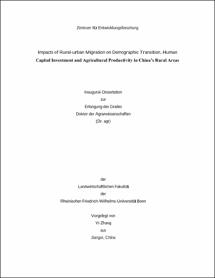Zhang, Yi: Impacts of Rural-urban Migration on Demographic Transition, Human Capital Investment and Agricultural Productivity in China’s Rural Areas. - Bonn, 2015. - Dissertation, Rheinische Friedrich-Wilhelms-Universität Bonn.
Online-Ausgabe in bonndoc: https://nbn-resolving.org/urn:nbn:de:hbz:5n-40730
Online-Ausgabe in bonndoc: https://nbn-resolving.org/urn:nbn:de:hbz:5n-40730
@phdthesis{handle:20.500.11811/6254,
urn: https://nbn-resolving.org/urn:nbn:de:hbz:5n-40730,
author = {{Yi Zhang}},
title = {Impacts of Rural-urban Migration on Demographic Transition, Human Capital Investment and Agricultural Productivity in China’s Rural Areas},
school = {Rheinische Friedrich-Wilhelms-Universität Bonn},
year = 2015,
month = jul,
note = {This dissertation focuses on the impacts of rural-urban migration on the rural areas in China. It consists of five chapters.
The first chapter introduces the research problems and presents the framework for studying three selected impacts of migration. These impacts are on the demographic change of the rural population, human capital investment, and agricultural productivity, and are all respectively discussed in the middle three chapters. The last chapter is a case study of a typical Chinese village with massive rural-urban migration.
The second chapter first estimates the scale and age-structure of the rural-urban migrants, and then separates the effects of migration on the rural demography by performing simulations with the Cohort Component Method and using data from China’s latest censuses in 2000 and 2010. In addition, it uses household data to confirm the huge effect of rural-urban migration on the demographic structure.
The third chapter develops a theoretical framework to investigate the relationship between migration and education. Empirical research reveals a robustly positive effect of migration on educational attainment among the stayers by proposing a novel instrument of the availability of local train stations to deal with the endogeneity.
The fourth chapter sets up a theoretical model to study the impacts of migration on agricultural productivity and empirically employs a Simultaneous Equations Model estimated by two-step-least-square method. Empirical results show that migration of the labor force reduces agricultural productivity and households with migration do not invest more in agriculture unless the land size reaches an optimal level. Migration along with land transfer can improve agricultural productivity.
The fifth chapter presents a case study of a Chinese village which is transforming its labor-intensive agriculture into a capital-intensive one based on changes in relative scarcity of production factors triggered by the rural-urban migration. It indicates that migration as an external force has broken equilibrium of the traditional agriculture and leads modern agriculture to take off by inducing capital to substitute for labor in agriculture.},
url = {https://hdl.handle.net/20.500.11811/6254}
}
urn: https://nbn-resolving.org/urn:nbn:de:hbz:5n-40730,
author = {{Yi Zhang}},
title = {Impacts of Rural-urban Migration on Demographic Transition, Human Capital Investment and Agricultural Productivity in China’s Rural Areas},
school = {Rheinische Friedrich-Wilhelms-Universität Bonn},
year = 2015,
month = jul,
note = {This dissertation focuses on the impacts of rural-urban migration on the rural areas in China. It consists of five chapters.
The first chapter introduces the research problems and presents the framework for studying three selected impacts of migration. These impacts are on the demographic change of the rural population, human capital investment, and agricultural productivity, and are all respectively discussed in the middle three chapters. The last chapter is a case study of a typical Chinese village with massive rural-urban migration.
The second chapter first estimates the scale and age-structure of the rural-urban migrants, and then separates the effects of migration on the rural demography by performing simulations with the Cohort Component Method and using data from China’s latest censuses in 2000 and 2010. In addition, it uses household data to confirm the huge effect of rural-urban migration on the demographic structure.
The third chapter develops a theoretical framework to investigate the relationship between migration and education. Empirical research reveals a robustly positive effect of migration on educational attainment among the stayers by proposing a novel instrument of the availability of local train stations to deal with the endogeneity.
The fourth chapter sets up a theoretical model to study the impacts of migration on agricultural productivity and empirically employs a Simultaneous Equations Model estimated by two-step-least-square method. Empirical results show that migration of the labor force reduces agricultural productivity and households with migration do not invest more in agriculture unless the land size reaches an optimal level. Migration along with land transfer can improve agricultural productivity.
The fifth chapter presents a case study of a Chinese village which is transforming its labor-intensive agriculture into a capital-intensive one based on changes in relative scarcity of production factors triggered by the rural-urban migration. It indicates that migration as an external force has broken equilibrium of the traditional agriculture and leads modern agriculture to take off by inducing capital to substitute for labor in agriculture.},
url = {https://hdl.handle.net/20.500.11811/6254}
}






